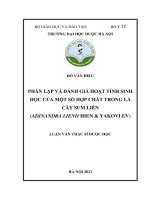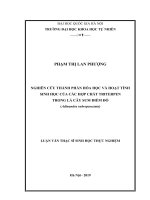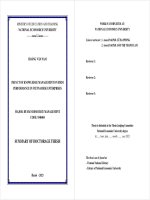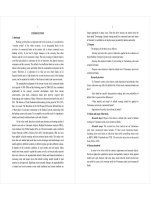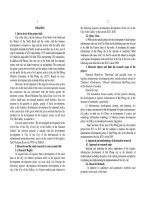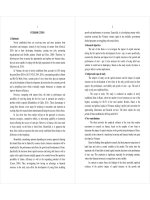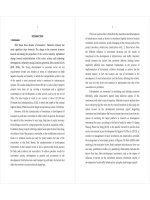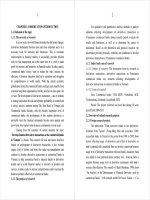- Trang chủ >>
- Thạc sĩ - Cao học >>
- Luật
La nguyenvanphuong sum
Bạn đang xem bản rút gọn của tài liệu. Xem và tải ngay bản đầy đủ của tài liệu tại đây (157.15 KB, 8 trang )
1
2
INTRODUCTION
1. About the thesis
The thesis researches the impact of natural resources tax on natural resource exploitation through the
survey at Ninh Binh province. The dissertation uses quantitative and qualitative research methodologies to
assess the impact of natural resource tax on resource saving, contribution to the State budget, business
efficiency and employees' income. From the research results, the thesis presents two groups of solutions to
enhance the positive impact of natural resources tax on natural resource exploitation at Ninh Binh province
in particular and the whole country in general.
The dissertation is presented in 152 pages; excluding the introduction, lists of figures, list of tables,
conclusions, lists of published works, references and appendixes, it is structured into 4 chapters.
Chapter 1: Overview of related research works and research methods.
Chapter 2: The theoretical background of the impact of natural resources tax and practical experience
for utilizing natural resource tax on natural resource exploitation.
Chapter 3: The situation of the impact of natural resource tax on natural resources exploitation at
Ninh Binh province.
Chapter 4: Orientations and solutions to enhance the impact of natural resource tax on natural
resource exploitation.
2. Rationale
Natural resources are extremely important to human beings. The current resources are exhausted by
humans exploiting indiscriminately, destroying the environment, causing negative externalities
unpredictable. The resource curse is a stingy way of addressing states that are sabotaging the digging of
underground wealth hoping to make an economic peak. One of the important economic instruments for both
resource saving and revenue generation is the natural resource tax. So far, no study has investigated the
impact of natural resource taxation on natural resources. From that point, the topic: "The impact of natural
resource tax on natural resources exploitation through the research at Ninh Binh province" was chosen
as the thesis topic of the author..
3. Purpose
Based on the factors influencing natural resource tax, the author analyzes the current situation of the
impact of natural resource tax on natural resources exploitation at Ninh Binh province. Applying modelbased research results, combined with the experiences from developed countries, the thesis proposed
solutions to enhance the impact of natural resource tax on resource exploitation.
4. Research question
Question 1: What are the criteria for assessing the impact of natural resource tax on resource
exploitation?
Question 2: Which factors influence the natural resource tax?
Question 3: What is the impact of natural resources tax on resource exploitation at Ninh Binh
province?
Question 4: What solutions should be suggested to related objects in enhancing the positive impact of
natural resource tax?
5. Subject and scope
- Research subject: The impact of natural resource tax on natural resource exploitation
- Research scope:
The aspect of conternt: The impact of natural resource tax on the exploitation of mineral resources
includes: limestone, brick making, leveling, coal, mineral water.
The aspect of scope: Ninh Bình province
The aspect of time: For the period from 2011 to the end of 2015.
6. New contributions of the thesis.
New contributions in theory
The thesis builds a theoretical framework for the impact of natural resource tax on the
exploitation of natural resources, the increase of the State revenue, the improvement of the business
efficiency at enterprises and the labour income. Based on the thesis model, qualitative and
quantitative criteria are used to assess the impact of natural resource tax on resource exploitation. The
thesis has pointed out the factors that influence the natural resource tax, to promote the impact of
natural resources tax should promote the factors affecting the positive.
Practical contributions.
Natural resource tax has an impact on thrifty exploitation and limited production of exploited natural
resources; increase revenues for the State budget; improving the efficiency of business production and the
\employees' income. Increasing tax rates and taxable prices have changed the volume of mining resources
and revenues for the State budget. When the tax rate increases, the taxable price increases within the
permitted limits, saving the exploited natural resources and increasing the State budget. The results of the
thesis combined with the practical experience from other developed countries applied to propose solutions to
raise the impact of natural resource tax on the thrifty exploitation of natural resources and increase the State
budget.
3
4
CHAPTER 1: OVERVIEW OF RELATED RESEARCH WORKS AND RESEARCH METHODS
Secondary document: The thesis collecting data from tax authorities and resource exploitation
enterprises.
Primary document: The thesis was conducted the survey in 47 mining enterprises and 185
managers at all levels.
1.3.3 Questionnaire and data collecting method
The data is collected from Tax Department of Ninh Binh, Lao Cai, Thanh Hoa to obtain tax
documents, provincial tax policy, results of exploitation and contribution to the State budget. Questionnaires
are conducted with 185 managers at three level of province, district or city, ward. Collecting data from
enterprises through surveys of 47 enterprises exploiting natural resources.
1.3.4 Research criterias and score scale
Criterias to assess factors affecting natural resource tax: the suitability of the relevant legal system,
the mechanism of natural resource tax, the capacity of the contingent of officials ... and the awareness of
exploiter. Indicators and scale for the impact on natural resource tax: contribution to the State budget, the
volume of exploited natural resources (the scale of exploitation), the operating efficiency of enterprise and
the income of worker.
1.3.5 Data analyzing method
Qualitative analysis of relevant data such as the appropriate level of taxable price, tax rate, taxable
output, ... according to the likert scale, due to SPSS and EXCEL.
Quantitative analysis of relevant data such as the annual natural resource tax contributing to the State
budget at Ninh Binh province, other localities and each enterprise exploiting natural resources, exploited
natural resources, ... based on average method supported by SPSS ans EXCEL.
1.1 Overview of related rsearch works
1.1.1 Research works in the world
There are two groups of studies on the impact of natural resource tax: studies on natural resource tax
and its impact in the aspect of theory and reality. The main findings of research in the world are: natural
resource tax as leverage to restrict or encourage exploitation. On the basis of a number of factors affecting
the natural resource tax, studies have shown some of the effects of natural resource taxes on the size of
mining firms, contributing revenues to the State budget, environment protection, overcome negative
externalities caused by resource exploitation.
However, the research has not synthesized the theory and practice of natural resources tax for
exploiting. The factors affecting the natural resource tax have ever analyzed fully. There is no basic for
calculating reasonable the natural resource tax. Natural resource tax impacts on resource-saving and Stae
revenue-increasing have not been clarified.
1.1.2 Research works in Vietnam
The research on natural resources tax in Vietnam is not enough; domestic research projects cover a
number of common tax issues, study the impact of taxes on the environment; overcome the negative
externalities caused by resource exploitaiton. Some studies have considered the factors that influence natural
resource tax; the analysis of natural resource tax is a tool for the State to regulate the exploitation of
resources and control the exploitation environment.
So far, there has been no research to synthesize the theoretical and practical basis abuot the impact of
natural resource tax on natural resource exploitation. The criterias for assessing the impact is not specified. It
is also the content this thesis mentioned.
1.2 Uncovered subject
From the concerns shown in previous researches and the concerns that have not been digged about the
impact of natural resource tax, the thesis points out uncovered subjects as the following: Which concerns
does the theoretical and practical background of the impact of natural resource tax on resource exploitation
and state budget collection cover? Which factors influence natural resource tax? Assessing the impact of
natural resource tax in order to provide solutions to enhance the impact.
1.3 Research design
1.3.1 Research model
Developing two criterias, qualitative and quantitative, to serve as a basis for assessing the impact of
natural resources tax on natural resources exploitation. Analyszing the factors impacting to to assess the
impact of natural resources tax on exploitation. Applying research results and experiences from other
countries to propose measures to raise the impact of natural resource tax. The contents of the study are
modeled as follows:
Research model on the impact of natural resoure tax
The
Contribution
Operating Workers’
number
to the State
Solutions
efficiency
income
of mining
budget
to
firms
enhance
Results on the impact of natural resource tax
the effect
of
natural
resource
Factors affecting natural resource tax
tax
Regulation
The State
The behavior
and natural
organization of
of mining
resource tax
natural resource
firms
policy
tax
1.3.2 Research methodology.
The general research methods of the thesis are: document research, method of abstraction, logichistory, analysis-synthesis, systematization, modeling and statistics. Specific research methods are
quantitative and qualitative research methods.
Conclusion of chapter 1
Through research works in the world and Vietnam, the thesis defines uncovered subject and design
research framework for the thesis. The author sets out the input scale indicators or the factors afftecting to
natural resource tax and the scale impacting results to evaluate the impact of natural resources tax in
Chapter 3 of the thesis.
5
6
CHAPTER 2: THE THEORETICAL BACKGROUND OF THE IMPACT OF NATURAL
RESOURCES TAX AND RACTICAL EXPERIENCE FOR UTILIZING NATURAL RESOURCE
TAX ON NATURAL RESOURCE EXPLOITATION
mining operations compared to other taxes. So it is the main theme of study. Principles for calculating
natural resource tax shall be based on the exploited natural resource output, the taxable price and the tax rate.
2.2 Theoretical background of the impact of natural resources tax on natural resource
exploitation
2.2.1 The two-sides of natural resource tax for exploiting natural resources.
When the natural resource tax policy is in line with reality, it will have a positive impact as regulating
the volume of exploited natural resources, ensuring thrift and efficiency, guaranteing revenue sources for the
State budget, encouraging enterprises to apply advanced technology, improving business profitability and
employees' income, raising public awareness about exploiting natural resource thriftly.
Conversely, if the tax rate is not reasonable, natural resource tax will negatively affect socio-economic
development. The tax rate is too low or the mobilization level for the state budget is negligible, the enterprise
is not aware relevantly the natural resource exploitation for short-term and long-term. If the tax rate is too
high, it will not attract the investment of enterprises to exploit the available resources, especially the types of
renewable resources.
2.2.2 Criteria for assessing the impact of natural resource tax on natural resource exploitation
Qualitative criteria is based on empirical descriptions, empirical hypotheses, hypotheses, and
interrelationships among entities in the process of exploitation. Qualitative criteria is based on reference to
prior researchs and research framework of thesis, including the criteria of suitability of taxable price, tax
rates, and the suitability of the types of resources included in the tax calculation.
Quantitative criteria is based on reference to previous studies, the research framework of the thesis
and the combination with practice. It is determined by specific criteria and evaluated by the criteria: the
amount of exploited natural resources, the amount of natural resource tax collected for the State budget, the
profit of business, employees' income.
2.2.3 Factors affecting natural resource tax
The natural resource tax is influenced by the following factors: the relevant legal system, the natural
resources tax regime, the State organization of natural resources tax management, the awareness of the
operators.
Among the factors mentioned above, the mechanism of natural resource tax policy has the strongest
impact. The taxable price and tax rates have a particularly important impact on the natural resources tax.
Their change, will change mostly the impact of the natural resource tax.
2.3 Experiences from other countries and localities on the use of natural resources tax for exploiting and
saving natural resources
2.3.1 Experience in several specific countries
Countries in the world use natural resource tax to influence mining behavior by authorizing the states to regulate
tax rates, the states detailing tax rates for each resource for regulation during the mining process. The majority of
provincial (state) resource taxes are calculated per unit of resource or selling price. This means that the natural resource
tax is calculated by the fourmula of "the tax payables = quantity * in a constant number. This calculation is intended to
be flexible to the tax level to enhance the impact of natural resource tax on contributions to the Government. In order to
encourage or limit the exploitation, several number of countries apply flexible tax exemption and reduction, areas with
difficult conditions shall be exempted, reduced or extended the tax payment. Thus, the application of natural resources
tax in countries around the world is very flexible across territories to regulate the exploitation or adjustment of revenue
to the Government.
For localities: Thanh Hoa, in order to improve the positive impact of natural resource tax on
exploitation, regularly adjusts the price when the market price changes over the range of 10% of current
prices. Some small, odd, mines in a large area or mines with many enterprises have demand for exploitation.
The province coordinates with the Department of Natural Resources and Environment to synthesize
exploitation results to closely monitor the declaration of exploited natural resources.
2.3.2 Lessons for Vietnam from practical experiences from other countries and vietnamese
provinces.
By studying and analyzing the use of natural resource tax in several countries in the world and in the
localities, the thesis draws some lessons for the use of natural resource tax for economical and efficient
exploitation in Vietnam and Ninh Binh as following:
Firstly, extending the area of taxable resources to cover all activities of mining resources and increase
the budget, and ensuring social balance among enterprises.
Secondly, flexible tax rates are used by the government to set tax rates and decentralization to local
2.1 Common theoretical issues on the exploitation and taxation of natural resource
2.1.1 Natural resources and the exploitation of natural resources in the process of sustainable
economic development
Natural resources are the source of energy, material or information that are created and existed in the
nature that humans demand to use for socio-economic development to apply their needs in life. There are
many types of natural resources, but non-renewable resources are becoming gradually exhausted, the typical
characteristic of the natural resource is its rareness. Thus, exploiting resources is not for the immediate future
but to save for sustainable economic development in the long-term.
The state performs the function of natural resource management by law, tools and macro policies to
exploit natural resources efficiently. Among all the tools that the State has put in place to manage natural
resources, the economic tool has a direct and effective affect that is natural resource tax.
2.1.2 Natural resource economy model
Natural resource economy model is described by the following figure:
Price
Demand curve 2
Economic rent
Long-run supply curve
Demand curve 1
Natural resource
Balancing natural resource market and the concept
of economic rent
The characteristic of many natural resources is that the supply is almost fixed. So, as market demand
grows, market equilibrium will create a net economic surplus that economists often call economic rent. The
essence of natural resource taxation is the recovery of economic rent.
Natural resources are owned by the State, enterprises pay natural resource tax as a form of natural resource
purchase from the State. The government levied natural resources tax as an economic measure to increase revenues for
the State budget and ensure social balance.
2.1.3 The theoretical background, the nature and general concerns of narutal resource tax.
The theoretical background of natural resource tax: Based on the theory of land rent, the specific
conditions of locality, the orientation and views of economic development of the Party and the State.
The state is representative for people ownership; therefore, land rent should be collected to ensure social
balance, regulate redistribution of income for workers. Land rent is the theoretical background for the
State to collect natural resource tax. This concern shows that the mining ground is the basis for
calculating the present tax.
The nature of natural resource tax: Natural resource tax is an indirect tax levied on the exploitation of
natural resources by organizations and individuals in order to encourage organizations and individuals to
exploit natural resources reasonably, economically and efficiently to contribute to protect natural resource,
ensure the State budget revenues, protect the environment, to overcome negative externalities caused by the
exploitation, regenerate, search and explore natural resources for sustainable socio-economic development.
The nature of this tax is superfluous in theory, and a cost that the mining firms paying to the State on
behalf of the consumer in practice that is accounted as operating expense. Thus, the theory and practice have
still existed a gap that needs further studying.
General concerns on natural resource tax: Natural resource tax has a remarkably strong impact on
7
8
governments to regulate the exploitation of each type of resource.
Thirdly, applying simple taxation price flexible in order to implement easily, simplificating tax
administration procedures, timely adjusting revenue of mining operations.
Fourthly, passing tax exemption or reduction to encourage or restrict exploitation of each kind of natural resource
and exploitation zone.
CHAPTER 3: THE SITUATION OF THE IMPACT OF NATURAL RESOURCE TAX ON
NATURAL RESOURCES EXPLOITATION AT NINH BINH PROVINCE
3.1 Overview of natural resources and the process of implementing the natural resources tax
policy at Ninh Binh province
3.1.1 Overview of natural resources at Ninh Binh province
Natural conditions at Ninh Binh province: Ninh Binh has an important strategic position, with roads
and North-South railway running through as well as dense system of rivers forming a waterway network
which is very convenient for exchange, economic development in and outside the province.
Resources at Ninh Binh Province: Limestone resources are Ninh Binh's largest mineral resource, with
tens of billions of cubic meters. At Ninh Binh, dolomite has tens of millions of tons; In addition, there are
abundant land resources used to fill, clay to produce bricks, mineral water resources for the production of
drinking water and soaking water...
Resource-exploiting enterprises at Ninh Binh province: currently, there are 70 resource-exploiting
companies at Ninh Binh province, mainly exploiting natural resources for construction materials production.
3.1.1 Institutions related to natural resource tax and its administration
According to the concept of Douglas North, institutions are the rules of the game in society.
Institutions and policies related to natural resource tax and management of natural resource tax such as
Mineral Law, Law on Environmental Protection, Law on Natural Resources, documents of Provincial
People's Committee and other tax laws. If the regulation is appropriate, the natural resource tax will have a
positive effect or conversely.
Thus, the institution and policy of natural resources tax and tax management has a positive or negative
impact depending on the relevance of good or bad institutions and policies.
3.1.2 Overview of the implementation of the natural resource tax policy in stages
The policy is implemented through four phases. From 1990 to 1995, tax reform was step 1. In the
period of 1995 - 2005, the tax reform was step 2. The period of 2006-2010 tax reform was step 3. In the
period from 2011 to 2015, the tax system reform was step 4. All stages of implementation are oriented
towards as natural resource tax is an efficient economic tool for managing and exploiting natural resources,
increasing revenue for the State budget with further producing to limit crude export.
3.2. The situation of natural resource tax impact on natural resources exploitation at Ninh Binh
province.
3.2.1 Impacts on regulating the production, and ensuring the economical exploitation of resources
To assess the impact on regulating the production and resource-saving exploitation, the thesis has
surveyed 47 mining enterprises, the results show that:
The magnitude of the impact of natural resource tax on resource savings was 3.93 on the Likert scale
(3.40 to 4.19). Limestone output of 22 cement companies in the period 2011-2015 decreased although
cement outputs did not decrease. When the tax rate for limestone, brick-making, mineral water and fill-up
land increased from 2% to 5% of the current tax rate, enterprises still maintain their mining activities. Based
on the above research results, natural resource tax has affected the average resource exploitation of about
10% per year. Tax rates are still possible to increase in most natural resources at Ninh Binh. The tax change
the impact of natural resource tax, the saving and the volume of natural resources not only in the quarrying
business but also in the other resource enterprises.
3.2.2 The impact on the State budget contribution.
The results of studying the impact of natural resource tax on the State budget contribution for the
period 2011-2015 in three provinces of Ninh Binh, Thanh Hoa, Lao Cai show that:
The natural resource tax contributed to the State budget has increased by an average of 20%, higher
than the average increase of other taxes. The proportion of natural resource tax to total revenue from taxes
and fees has increased. The highest is the Lao Cai with the natural resource tax in 2015 accounted for 19.4%
of total revenue.
Specific research at five land reclamation and mining companies concluded that when tax rates
increased, natural resource tax increased at the same rate as tax rates.
3.2.3 Impact on the promotion for enterprises to improve operating efficiency
The results of two sample surveys M1 (enterprise) and M2 (staff), assessment of the level of
technology improvement production, exploitation of resources, increase income for workers ... have an
average score of 3.79 on the Likert scale (3.40 to 4.19). The results of business activities of 47 enterprises in
the period 2011 - 2015 also show that the average turnover of an enterprise's profit increasing from 20 billion
in 2011 to 40.2 billion in 2015. In the period from 2011 to 2015, the thesis rresearch on 12 enterprises
CONCLUSION OF CHAPTER 2
Natural resource tax is an economic tool of the State, which is a social economic intervention. The
natural resource tax is influenced by many factors such as the related legal system, natural resource tax
policy ... In which the natural resources tax policy is the most important factor. In the resource tax policy,
the tax rate and the taxable price are the most influential factors. In order to improve the positive impact of
resource taxation, it is necessary to promote the factors influencing, in particular, the tax rate factors and
the taxable price in a positive way.
From the practical experience of using natural resource tax in several countries in the world and in
the provinces, the thesis draws four lessons for Vietnam on the use of natural resource tax for resourcesaving exploitation, increasing revenues for the State budget and providing the basis for proposing solutions
in Chapter 4.
10
producing bricks on the renovation of enterprise performance management has reduced the number of direct
workers per year although the production output did not decrease.
Based on the research results, the author affirms that natural resource tax will improve the operating
efficiency of enterprises.
3.2.4 Impacts on the income and livelihood of workers in the field of resource exploitation
According to the study, 47 enterprises exploiting natural resources in the period from 2011 to 2015
showed that:
The natural resource tax in this period increased significantly due to tax rates, taxable prices increased,
although the mining output of enterprises did not increase. The total operating expenses has not increased
but decreased compared to the previous years leading to increase profits. The average income of workers
has increased for the perid 2011-2015, from VND 3.09 million per person per month in 2011 to VND 4.38
million per person per month in 2015.
Thus, natural resource tax have affected the income and livelihood of workers in the resource
exploitation sector.
The results of the study on the impact of natural resources tax on natural resource exploitation show
that natural resource tax has the strongest and most obvious impact on the State budget revenue.
Additionally, it impacts on resource saving, and regulates the volume of exploited resources. The impact on
the income and livelihood of workers in the field of resource exploitation is not clear.
3.3 The assessment of impact of natural resources tax on natural resource exploitation at Ninh
Binh province
3.3.1 Evaluating the results
The revenue source for the State budget is ensured. The research results show that the natural resource
tax revenue has seen a high growth rate over the previous year. Natural resource tax revenue in 2011
increased by 167% compared to 2010; 2015 is 120% higher than in 2014.
Natural resource tax has not taken a main proportion, the trendline in production output is downside as
described by the picture belows:
The proportion of natural resource
tax (%)
9
2,4
2,3
0
8
2,2,05
1,96
1,95
2011
2012
2013
2014
2015 Year
The proportion of natural resource tax at Ninh Binh province over the years
Source: The report of Tax Department of Ninh Binh province from 2011 to 2015
The management of natural resource exploitation contributing to protect the environment is enhanced.
Recently, the Provincial People's Committee has directed the levels of sectors to coordinate with the tax
department to manage the exploitation of natural resources and increase the State budget revenue. Firms
exploit resources more thriftly. Natural resource tax revenues have contributed significantly to the local
capital for investment in infrastructure and environmental improvement.
The awareness of individuals, organizations in the exploitation of resources and the fulfillment of tax
obligations is improved: Resource tax is the input cost of the production process, forcing businesses to
calculate to save resource. The results of the study in section 3.2 show that enterprises are increasingly
raising their awareness on resource-saving exploitation.
Through inspecting and guiding, the violations related to natural resource tax is handled to ensure
equality among enterprises, and raise the sense of observance of tax obligations of enterprises to be better
and better.
The research results in section 3.2 show that natural resource tax is a source of income for the state
budget, it contributes to the protection of the mining environment, enhances the awareness of enterprises in
the exploitation and performance of tax obligations.
3.3.2 Limitations
The natural resource tax accounts for a small proportion of the State budget: Total revenues from
natural resource tax compared with total State revenues, total tax revenues, fees are under-expected.
Compared to the total revenue from taxes and fees, the natural resource tax from 2011-2015 accounts for less
than 2%.
Generalizing natural resource tax contribution from 2010 to 2015 at Ninh Binh province
Unit: VND in billions
Order
Criteria
FY2011 FY2012 FY2013 FY2014 FY2015
A
1
2
3
4
5
B
Total State
1
2,783
2,306
2,843
2,833
3.,611
contribution
Total tax & fee
2
1,669
1,872
2,193
2,290
2,733
contribution
Total natural
3
resource tax
32.64
36.65
44.86
54.67
65.48
contribution
The proportion
4
compared to total
1.95
1.96
2.05
2.38
2.4
tax & fee
11
Order
A
Criteria
B
contribution (%)
FY2011 FY2012 FY2013 FY2014 FY2015
1
2
3
4
5
Source: The report of Tax Department of Ninh Binh province in 2016
Natural resource tax has not really become an effective tool of the State to manage and exploit
resource tthriftly: The mess exploitation of natural resources is a national problem as well as Ninh Binh's.
Limestone resources are exploited indiscriminately without planning which affects the ecological and
tourism environment. Limestone mining and mixing to tourism development is a painful concern. Natural
resource tax has not really played a role in regulating resource-saving exploitation.
The policy on natural resources tax also has some inappropriate content that limits the its impact: The survey
results of 185 managers and 47 enterprises showed that taxpayers and taxable objects have not been covered causing loss
of natural resource tax. Taxable price, tax rates are inadequate and lack of flexibility resulting in limiting the efficiency of
resource saving and the increasing in the State budget. Large tax exemption and reduction, integration of other policies
makes the impact of resource tax unequal among mining enterprises.
3.3.3 Causes
The results assessing the level of achievement of the factors related to natural resource tax policy
through 185 managers and 47 enterprises showed that:
The content of some regulations relating to the natural resources tax policy remains inadequate and
incomplete with the natural resource policy.
The implementation of the Tax Laws has not been coordinated closely with local authorities at all
levels. The procedures for managing the collection of natural resources tax and other revenues for natural
resources have not been synchronized simply to reform administrative procedures for enterprises.
The progapanda supporting to taxpayers and coordinatinf activities have not been closely coordinated.
Organizing propaganda as a special topic on natural resource tax for enterprises has not been implemented
but still integrated. The coordination of relevant agencies and organizations in the management of collecting
natural resource tax is not regular.
The tax officials have several restriction in capacity and responsibility that influences the management
of natural resource tax, limits its role for sustainable economic development.
Research results on the assessment of the level of tax rate, taxable price, tax exemption and reduction
within 232 questionnaires showed that the causes of limitation are due to the natural resource tax book,
taxable price, tax rates, tax exemptions, .... are not suitable with current management practice.
The causes mentioned above have limited the impact of natural resource tax, causing the impact to be
distorted, limiting the positive aspects.
CONCLUSION OF CHAPTER 3
Chapter 3 is the result of studying the impact of natural resource tax on resource exploitation at Ninh
Binh province which showed that:
The natural resource tax has the strongest impact, most clearly to increase the State budget.
Additionally, it impacts on resource saving and regulates the volume of natural resources. The impact on
income and life of workers is unclear.
The natural resource tax has the effect of saving about 10% of the natural resources exploited each
year and reducing annual production. The State budget increase is about 20% per year, higher than the
average increase of taxes and fees. The proportion to the State budgets tends to increase year by year,
although the output does not increase. As the tax rate increases, the natural reosurce tax increases at the
same proportion.
The tax rate for limestone, brick, mineral water and leveling soil increases by 2% - 5% compared to
the current tax rate. This is the basis for adjusting the tax rate.
Two new types of resources are scenic spots and the number of telephone subscribers included in the
calculation of natural resource tax is absolutely reasonable.
.
12
CHAPTER 4: ORIENTATIONS AND SOLUTIONS TO ENHANCE THE IMPACT OF NATURAL
RESOURCE TAX ON NATURAL RESOURCE EXPLOITATION
4.1 Guidelines and directions to enhance the impact of natural resource tax on natural resource
exploitation
4.1.1 The situation and policy of exploiting natural resources
The international and domestic contexts of natural resources exploitation and use: Vietnam as well as
other countries in the world, especially underdeveloped and developing countries, natural resource is
exploited, used indiscreminately, less efficiently, and increasingly exhausted. The lack of awareness causes
environmental pollution. Renewable resources are degraded, transformed in a negative direction, causing
negative externalities for human beings.
The requirement for Vietnam as well as other countries to use natural resource taxation tools to
manage and save resources, increase the State budget and overcome negative externalities caused by mining.
These issues require a natural resource tax policy and related policies to be designed to promote the
enhancement of the impact of natural resource taxation on natural resource exploitation.
Background and policy changing the growth model of Vietnam: More than 30 years of renovation of
economic growth model, Vietnam achieved certain achievements: however, the growth model is slowly
changing. Social resources, especially natural resources, are not being promoted. The concern between
resource exploitation and negative externalities caused during exploitation is not clearly calculated.
Derived from the situation mentioned above, it is necessary to change the growth model. Promoting
the application of scientific and technological advances helps create more efficient exploitation of resources,
but not regardless any price. It does not mean to stop exploiting resources to limit the negative externalities
caused by mining. The problem is to exploit thriftily and limit exploitation, but still ensure sustainable
economic development.
13
4.1.2 The orientation to improve the impact of natural resources tax on natural resource
exploitation
The natural resources tax policy should be completed in line with the viewpoint of the Party and the
State without the discrimination of economic sectors, ensuring social balance and development motivation.
The natural resource tax must be simple, transparent, fair, easy to implement, consistent with
international taxation. It should not incorporate many other socio-economic policies. Incorporation of
various policies often leads to conflicts within the objectives of the tax law.
It should ensure an increase in the State budget and a macro-regulatory role of the State. The main objective
of natural resource tax is to generate revenue for the State budget and regulate the exploitation of resources.
Therefore, the tax rate is appropriate, the calculation based on the scientific basis and survey database to ensure the
role of macro-regulation of the State in the economical exploitation, revenues for the State budget and development
requirements.
In order to ensure the efficient and economical exploitation of natural resources, it is necessary to have
a policy on appropriate natural resources tax to restrict the exploitation of natural resources in general and
precious and rare natural resources in particular.
4.2 The solutions to enhance the impact of natural resources tax on natural resource exploitation
4.2.1 The group of solutions on policy mechanism and laws related to natural resource tax
Based on the research results in chapter 3 on the level of attainment of legal policies related to natural resource tax
and limited liability, the thesis presents five solutions as following:
Firstly, the solution to improve the content of some of the laws related to resource tax policy
contributing to promote the impact of natural resource tax in a positive direction.
Secondly, strengthening the management and implementation of tax laws to ensure that natural
resource tax is in line with current practice, raising the role of natural resource tax.
Thirdly, intensifying the inspection, supervision and handling of tax law violations in a timely manner;
ensuring fairness among enterprises exploiting natural resources in particular, whole enterprises in general.
Fourthly, improving the capacity and qualifications of cadres formulating tax policies, in order to
complete the policy as well as the management of natural resources tax. presently. It contributes to
enhancing the positive impact of natural resource tax on the exploitation of natural resources.
Fifthly, raising the awareness and the sense of duty of taxpayers to ensure the resource tax has a more
positive impact.
4.2.2 The group of solutions to complete the content of natural resource tax policy
Using research results on the impact of natural resource in Chapter 3, limitations and causes combined with the
experience using the natural resource tax tool in other countries, the thesis offers 4 solutions as belowed.
Firstly, the research results, evaluating analysis in Section 3.3.2 show that the provisions on taxpayers
in natural resources tax are not appropriate, it is necessary to complete regulations for taxpayers to manage
tightly the source of revenue for the State budget, and raise the impact of natural resource tax.
Secondly, the experience from other countries is to extend the tax base to cover all of the resource
exploitation activities, as well as the constraints on taxpayers analyzed in Chapter 3, and the expansion of
taxable objects are neccessary to ensure the fairness on natural resource exploitaion.
Thirdly, the results in Chapter 3 on the situation impact, the analysis of the constraints and the causes on the
impact show that the tax bases are currently restricting the impact. From the practical experience, the thesis proposed
the direction of adjusting tax bases to enhance the impact of natural resource tax as following:
The regulations on the production of taxable natural resources should be adjusted in line with the practical
requirements to ensure the favorable application of taxpayers and management agencies. The tax calculation price
should be completed in the direction of simple and easy-to-implement to ensure be closed to market prices.
Particularly, appling the natural resource tax calculation price based on the selling prices of products for
simplification of administrative procedures and raising the impacts of taxation. Appling flexible tax rates and set the
tax bracket for decentralization to local governments. Research shows that the current tax rate can still be adjusted to
increase in some types of resources.
Fourthly, from the results in chapter 3 and the experience from other countries on tax exemption and
reduction to encourage or limit exploitation, the thesis proposes to narrow the cases of tax exemption and reduction
to bring into play the positive effects of taxation.
14
CONCLUSION OF CHAPTER 4
Chapter 4 applied the research results in Chapter 3, practical experience of other countries in
Chapter 2 to provide solutions to enhance the impact of natural resources tax on natural resources
exploitation.
The thesis proposes two groups of solutions those are a group of solutions on policies and legislation
related to natural resources tax and a group of solutions on finalizing the contents of the taxation policy for
managers to consult. The resolution on the content of natural resource tax policy is considered by the
author. In this group of solutions, the finalization of tax rates and taxable prices need special attention.
These two factors change with the impact of a substantial change in natural resource taxation.
academic scientific seminar: solutions to improve the efficiency of insurance business management in Vietnam, Academy of Finance and Baoviet Holdings on
1. Nguyen Van Phuong (2015), ‘The impact of natural resources tax on the situation of exploiting and utilizing natural resources at Ninh Binh province’,
12/2015.
socioeconomic’, Journal of Finance and Accounting, Academy of Finance No 01, 01/2016.
2. Nguyen Van Phuong (2016), ‘The impact of natural resources tax on the development of economTác động của thuế tài nguyên đến sự phát triển
3. Nguyen Van Phuong (2016), ‘The impact of natural resources tax on the situation of exploiting and utilizing natural resources at Ninh Binh province’,
15
Journal of Finance and Accounting, Academy of Finance No 02, 01/2016.
CONCLUSION
The natural resource tax is an important economic tool of the State to regulate the exploitation of
natural resources. Natural resource taxation in the past few years has had a positive impact on resource
saving and contribution to the State budget. However, its impact on mining behavior is still restricted.
Globally, many researchs on the impact of natural resource tax on the exploitation of natural resources have
been studied; however, the thesis is the first study in Vietnam.
The thesis draws a new point of theoretical research that the natural resource tax is influenced by the
relevant legal system, the natural resources tax regime and the State organization of natural resources tax
management, the awareness of the operators. In which, the natural resources tax regime is the most important
factor, in detailed, the tax rate and the taxable price are two factors that are particularly important.
In order to promote the impact of natural resource tax on production thriftly and increasing the State
budget revenues, it is necessary to promote the factors influencing the natural resource tax including the
relevant legal system, the natural resource tax policy, the State organization of natural resources tax
management, the awareness of operators, in the positive direction; especially, tax rate and taxable price
should be considered.
Contribution in practice: The natural resource tax has the strongest impact, most clearly to increase
the State budget revenues, save resources and regulate the volume of natural resources. However, the impact
on income and life of workers are unclear.
For the period from 2011 to 2015, it has been three times tax rate changed and four times taxable price
changed. The natural resource tax has a saving of 10% per annum on natural resources and a decrease in
annual production (the largest reduction is in limestone). The State budget revenue increase is about 20% per
year, higher than the average increase of other taxes. The proportion to the State budget tends to increase
year by year, although the output does not increase. In the case where the tax rate is increased, the natural
resource tax shall be increased to a percentage corresponding to the increase in the taxable price. The tax rate
of limestone, brick, mineral water and leveling soil increases by 2% - 5% compared to the current rate. This
is the basis for regulating mining output and adjusting the tax rate.
The results of research on two new types of natural resources as famous spot and the number of
telephone subscribers included in the natural resource tax calculation are well grounded in both theoretical
and practical aspects, in order to ensure social fairness and increase the State budget for Ninh Binh in
particular, the whole country in general.
Applying research results and experiences from other countries, the two groups of solutions to raise
the impact of natural resource tax are: group of solutions on policy mechanism, laws relating to natural
resource tax and group of solutions to complete the content of the natural resources tax policy for managers
to consult.
Although the thesis has achieved certain results, but some limitations those are the argument about the
characteristic of natural resource tax has not been resolved thoroughly, between theories and practices the
contradictory need continuing researching. The scope of research is still narrow at Ninh Binh province.
There are no quantitative calculations based on the models, so it is not possible to accurately estimate the
volume of taxation saved for each resource when the resource tax rate changes. Although there are
limitations, the thesis has completed the objectives and research tasks. The analysis of the impact of natural
resource tax and the solution of the thesis are used for subsequent research work, for reference managers to
apply in practice. The author looks forward to hearing specialist's opinions to complete the thesis.
A sincere thank!
LIST OF SCIENTIFIC WORKS DISCLOSED

